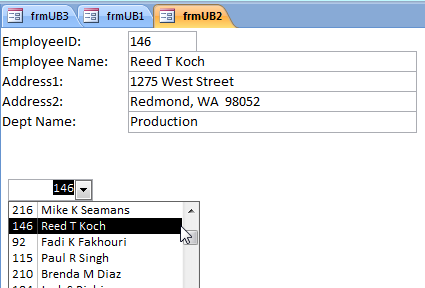Access Vba Recordset Update Records
Dealing with non- updateable queries in Microsoft Accessby Luke Chung, President of FMS Inc. Sample database: nonupdateable. KB)Overview. The queries in Microsoft Access are fantastic. They allow you to. They can. be chained together (one query uses another query), and are used. MS Access forms and reports.

VBA example - Microsoft Access: using recordset methods of adding, updating, deleting records in a table and list box. Tutorial: VBA Traps: Working with Recordsets. Things to look out for when working with recordsets.
Bug warning: If the function returns more than 255 characters, and you use it in a query as the source for another recordset, a bug in Access may return garbage for. Microsoft Cursor Engine Error Out Of Memory on this page.
There are many types of queries. When you. view the datasheet of a Select query, you can edit the results and your. This works even when the. Unfortunately, there are. Error Message: This Recordset is not updateable. When you try to edit the query, this message appears in the status. Some are. pretty obvious: The query is a Totals query (uses GROUP BY) or Crosstab query.
Access Vba Recordset Update Records In Sql
TRANSFORM), so the records aren't individual records. The field is a calculated field, so it can't be edited. You don't have permissions/rights to edit the table or database. The query uses VBA functions or user defined functions and the. Some reasons are less obvious but can't be avoided: The table being modified is a linked table without a primary key. For certain backend.
Microsoft SQL Server), Access/Jet requires the table to be. This makes sense since Access wants to. SQL query for modifications but can't uniquely identify the. Less obvious are these situations: Queries with some summary fields linked to individual. Queries with multi- table joins that are not on key fields. Union queries. The most obvious and annoying situations are queries on one table with totals (Group By, Sum.
Count, Average, etc.) that aggregate multiple records. However, if any. portion of your query contains a summary (GROUP BY) field, all the fields of the returned. This paper. discusses some ways around this limitation. Example 1: Editing a Table with a Summary Field. For example, a query listing all the customers ranked by how much. The first query provides the sales summary for each customer: qry.
Customer. Sales query: Total Sales by Customer. The second query uses the first query to show the customers: qry. Top. Customers query: Customers with their Total Purchases. Query Results Showing Sales by Customers.
The query results are very nice and can be used in forms and reports. No such luck. Because there is a summary. Example 2: Updating a Field with a Summary Query. Similarly, if your Customer table has a field to store summarized.
Update Query should do the trick: qry. Update. Customer query: Attempt to update field with data from a Summary query. Operation must use an updateable query (Error 3. If you run this query, you get this error message: Query Failed: Operation must use an updateable query.
This is very annoying. One way to resolve this is to use module code. Customers table and one for the.
Customer. Sales query, then manually update the Customers records. A better way. is to use temporary tables. Workaround: Use a Temporary Table. By using temporary tables, you can eliminate a lot of unnecessary code. 3Ds Max Vray Free Download Crack Idm. Make Table Queries. Make- Table queries are just like Select queries except their results. You specify the. table name and it is created.
If the table exists, it is replaced. To. create a Make- Table query, open the query (qry.
Customer. Sales) in design. Make- Table Query from the Query menu.
A dialog lets you. Make Table Query puts its results in table: tbl. Temp. Customer. Sales. Once you create the temporary table, using it rather than the summary query allows the two previous examples to work: Displays Updateable Records (example 1).
Updates the . Append. If. you just have a one step process, there usually is not much difference. Make- Table queries assigns its own. This is particularly. An Append query can use a table with indexes and other field. Make Table query cannot specify. Append queries can be used to insert records into a table with.
The fields may be updated later with other. Append queries let you accumulate results from multiple queries. For these reasons, you should become familiar with Append queries. I usually use a Make- Table query to do.
Convert your Make- Table query to an Append query. When designing. the query, select Append Query from the Access Query menu. In the. query grid, specify the fields in the . Notice how. the Append To field names do not need to match the field names or. Append Query: Notice how field Expr. From Total Visual Source. Book, here. Each user must have their own database where temporary tables are.
The database can be linked to a shared database. This is the proper way to design an Access application anyway. For more information on this type of architecture, read our paper on. Splitting Microsoft Access.
Databases to Improve Performance and Simplify Maintainability. Conclusions. Make sure you spend the time to understand how to use Access queries. The use of. temporary tables is fundamental to working around the annoying. Additional Resource. About the Author. Luke Chung is the.
FMS, Inc., a database consulting firm and the. Microsoft Access add- in products. He is the. designer and co- author of several Access add- ins including. Total Access Analyzer. Total Visual Code. Tools. Total Access Detective. Total Access Emailer.
Total Visual Source. Book, and. Total Access Statistics. He. has spoken at a variety of conferences and user groups. Copyright . All rights reserved. This information may not be republished, reprinted or. FMS. Inc. The information provided in this document is provided.